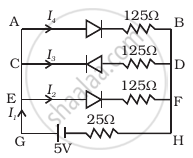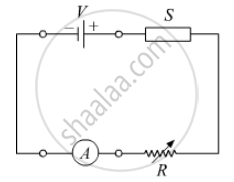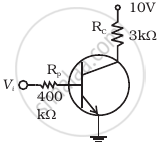Advertisements
Advertisements
Question
If each diode in figure has a forward bias resistance of 25 Ω and infinite resistance in reverse bias, what will be the values of the current I1, I2, I3 and I4?

Solution
According to the problem, forward biased resistance = 25 Ω and reverse biased resistance = ∞
As shown in the figure, the diode in branch CD is in reverse biased which has infinite resistance.
So, the current in that branch is zero, i.e. I3, = 0
Resistance in branch AB = 25 + 125 = 150 Ω say R1
Resistance in branch EF = 25 + 125 = 150 Ω, say R2
AB is parallel to EF
So, effective resistance
`1/R^' = 1/R_1 + 1/R_2 = 1/150 + 1/150 = 2/150`
⇒ R' 75 Ω
Total resistance R of the circuit = R' + 25 = 75 + 25 = 100 Ω
Current `I_1 = V/R = 5/100` = 0.05 A
According to Kirchhoff's, current law (KCL),
I1 = I4 + I2 + I3 .....(Here I3 = 0)
So I1 = I4 + I2
Here, the resistance R1 and R2 are same.
i.e., I4 = I2
∴ I1 = 2I2
⇒ `I_2 = I_1/2 = 0.05/2` = 0.025 A
And I4 = 0.025 A
Therefore, we get, I1 = 0.05 A, I2 = 0.025 A, I3 = 0 and I4 = 0.025 A.
APPEARS IN
RELATED QUESTIONS
When a forward bias is applied to a p-n junction, it ______.
In the following diagram 'S' is a semiconductor. Would you increase or decrease the value of R to keep the reading of the ammeter A constant when S is heated? Give reason for your answer.

With reference to semiconductor devices, define a p-type semiconductor and a Zener diode.
What is the use of Zener diode?
A triode value operates at Vp = 225 V and Vg = −0.5 V.
The plate current remains unchanged if the plate voltage is increased to 250 V and the grid voltage is decreased to −2.5 V. Calculate the amplification factor.
We use alloys for making standard resistors because they have ____________.
In the depletion region of a diode ______.
- there are no mobile charges.
- equal number of holes and electrons exist, making the region neutral.
- recombination of holes and electrons has taken place.
- immobile charged ions exist.
A Zener of power rating 1 W is to be used as a voltage regulator. If zener has a breakdown of 5 V and it has to regulate voltage which fluctuated between 3 V and 7 V, what should be the value of Rs for safe operation (Figure)?

In the circuit shown in figure, when the input voltage of the base resistance is 10 V, Vbe is zero and Vce is also zero. Find the values of Ib, Ic and β.

Draw the circuit arrangement for studying V-I characteristics of a p-n junction diode in (i) forward biasing and (ii) reverse biasing. Draw the typical V-I characteristics of a silicon diode.
